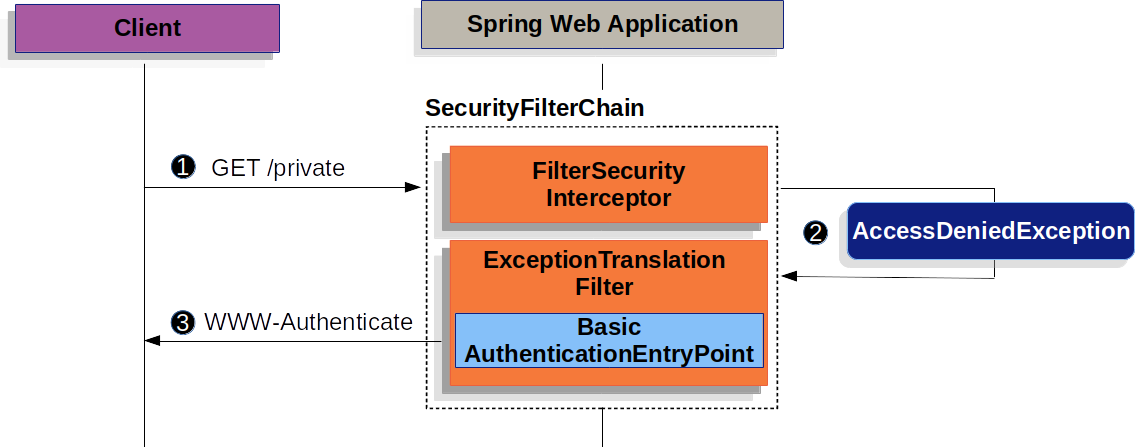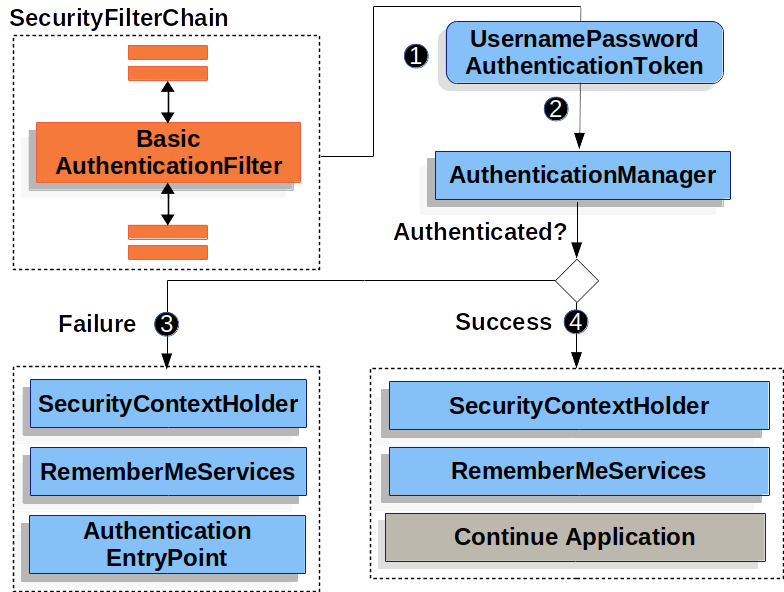Basic Authentication
This section provides details on how Spring Security provides support for Basic HTTP Authentication for servlet-based applications.
This section describes how HTTP Basic Authentication works within Spring Security. First, we see the WWW-Authenticate header is sent back to an unauthenticated client:

The preceding figure builds off our SecurityFilterChain diagram.
![]() First, a user makes an unauthenticated request to the resource
First, a user makes an unauthenticated request to the resource /private for which it is not authorized.
![]() Spring Security’s
Spring Security’s AuthorizationFilter indicates that the unauthenticated request is Denied by throwing an AccessDeniedException.
![]() Since the user is not authenticated,
Since the user is not authenticated, ExceptionTranslationFilter initiates Start Authentication.
The configured AuthenticationEntryPoint is an instance of BasicAuthenticationEntryPoint, which sends a WWW-Authenticate header.
The RequestCache is typically a NullRequestCache that does not save the request since the client is capable of replaying the requests it originally requested.
|
The default HTTP Basic Auth Provider will suppress both Response body and |
When a client receives the WWW-Authenticate header, it knows it should retry with a username and password.
The following image shows the flow for the username and password being processed:

The preceding figure builds off our SecurityFilterChain diagram.
![]() When the user submits their username and password, the
When the user submits their username and password, the BasicAuthenticationFilter creates a UsernamePasswordAuthenticationToken, which is a type of Authentication by extracting the username and password from the HttpServletRequest.
![]() Next, the
Next, the UsernamePasswordAuthenticationToken is passed into the AuthenticationManager to be authenticated.
The details of what AuthenticationManager looks like depend on how the user information is stored.
![]() If authentication fails, then Failure.
If authentication fails, then Failure.
-
The SecurityContextHolder is cleared out.
-
RememberMeServices.loginFailis invoked. If remember me is not configured, this is a no-op. See theRememberMeServicesinterface in the Javadoc. -
AuthenticationEntryPointis invoked to trigger the WWW-Authenticate to be sent again. See theAuthenticationEntryPointinterface in the Javadoc.
![]() If authentication is successful, then Success.
If authentication is successful, then Success.
-
Any already-authenticated
Authenticationin theSecurityContextHolderis loaded and its authorities are added to the returnedAuthentication.-
The Authentication is set on the SecurityContextHolder.
-
RememberMeServices.loginSuccessis invoked. If remember me is not configured, this is a no-op. See theRememberMeServicesinterface in the Javadoc. -
The
BasicAuthenticationFilterinvokesFilterChain.doFilter(request,response)to continue with the rest of the application logic. See theBasicAuthenticationFilterClass in the Javadoc
-
By default, Spring Security’s HTTP Basic Authentication support is enabled. However, as soon as any servlet based configuration is provided, HTTP Basic must be explicitly provided.
The following example shows a minimal, explicit configuration:
-
Java
-
XML
-
Kotlin
@Bean
public SecurityFilterChain filterChain(HttpSecurity http) {
http
// ...
.httpBasic(withDefaults());
return http.build();
}<http>
<!-- ... -->
<http-basic />
</http>@Bean
open fun filterChain(http: HttpSecurity): SecurityFilterChain {
http {
// ...
httpBasic { }
}
return http.build()
}
